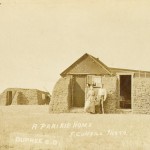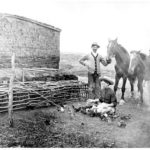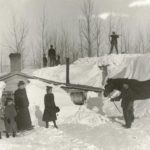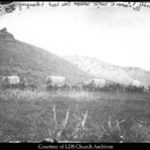In contrast to the Gilded Age mansions of the Vanderbilts and Rockefellers (see last post), most American families lived in considerably humbler abodes during the late nineteenth century. Families striving to create a new life in western lands often lived primitively, creating a first home out of whatever materials came to hand. Because trees were scarce, sod homes were common in the prairie states. It was far more important to build by a stream or within the shelter of a hill than to strive for a certain architectural style or type of building material.
Sod homes were difficult to build, but they were cheap and a definite step up from the dugouts that many families stayed in when they first settled. Dugouts were merely holes in the side of a hill which families quickly excavated in order to get out of their tents and covered wagons. Many times, they built their sod home in front of the original dugout and kept using the dugout as a room. Sod homes could be cozy and warm, and because they were built of dirt, fireproof. However, snakes, mice, and insects could find their way in, and often did. Dirt was a constant problem, and earth sometimes dropped in chunks from the ceiling or trickled down in a muddy drizzle during rainy weather. The roof itself might collapse during heavy rains, while underfoot, the floor turned to mud. Women could be constantly exasperated by the drawbacks of sod homes, and many wished for the relative comforts they had left behind in the East.

Prairie Home in Dupree, SD, courtesy Special Collections and University Archives, Wichita State University

Early Homes for Settlers in SD, courtesy Special Collections and University Archives, Wichita State University
______________________________________________________________________________________






